The Atacama Desert has been on my bucket list for a long time. We have traveled to Chile numerous times and on my seventh trip finally made it. The following is a summary of our visit the desert and to the Bolivian saltpans.
November 30 to December 2, 2022 – Miami to Santiago
Early this afternoon we left our home in Osprey and drove to Miami International Airport. It was an uneventful trip, except for the Motorcade of law enforcement vehicles (cars, trucks and motorcycles). I have seen motorcades before, but this one was the largest we have ever seen. We drove at least two miles until we got to the entry point of the motorcade… they were still coming onto northbound Interstate 75. We were lucky, as we were heading south.
We arrived at Miami International Airport several hours before flight time. Having experienced the crowds at this airport, we wanted to have a cushion of time. a couple waiting for their flight to Spain was sitting across the aisle from us. We wound up having a long chat with them. They were spending the winter an hour’s drive from us. We exchanged contact information and promised to get together at our home after we got back… We spent a nice evening with them after we got back,
Our flight was scheduled to depart at 9:15pm and was just a few minutes late. We arrived in Santiago on schedule and after going through immigration and agricultural checkpoints we were met by our driver for the ride to our hotel. We have been in Santiago several times, so we didn’t do the tourist stuff. We spent the next day and half with my cousins and their extended family.
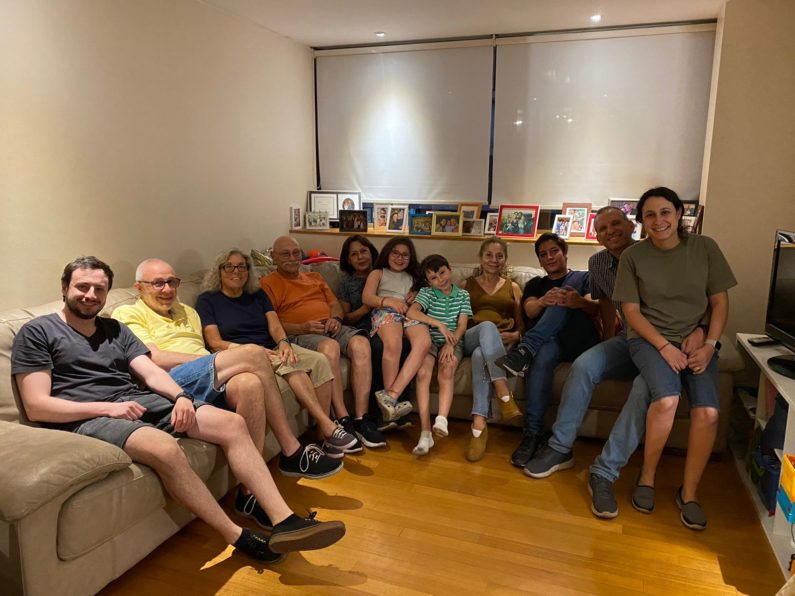
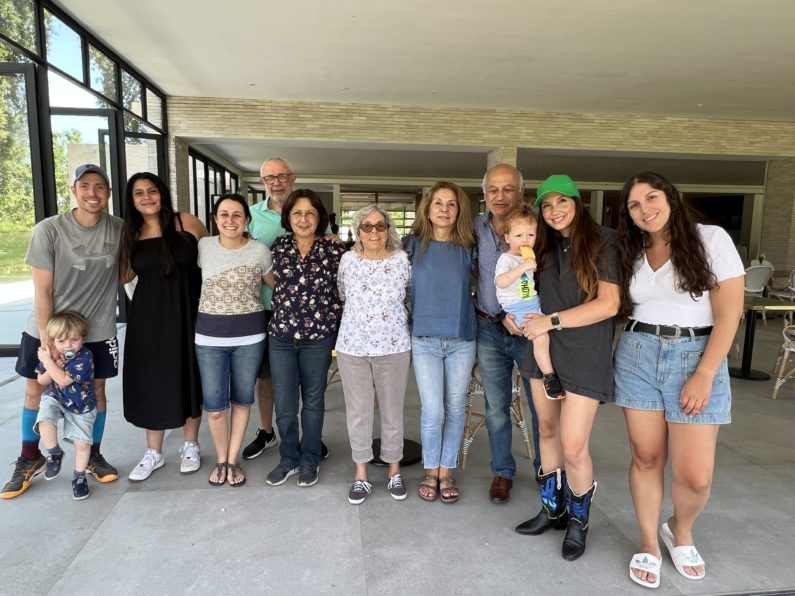
December 3, 2022 – Santiago to Calama and San Pedro de Atacama, Chile
An early morning. A driver was picking us up and take us to the airport for the two hour flight to Calama in northern Chile. In Calama, we were greeted by a driver who took us to the Altiplanico Atacama Hotel in San Pedro de Atacama, our base for the stay in the Atacama Desert. The trip from Calama to San Pedro de Atacama was sixty miles on a paved road, one of the few we would see during our days in Chile and Bolivia. The road gave us our first taste of the elevations we would encounter during our stay. Calama is located at 7,400 feet. The road climbed at a modest rate to a 11,400 foot pass, and then dropped to 8,000 feet at San Pedro. Arriving at the hotel we had some time to get settled before we were picked up for our first tour. The tour took us Laguna Cejar, Laguna Tebinquinche and Ojos del Salar (Eyes of the Saltpan).
Laguna Cejar is a lake that has a high level of salt which, like the Dead Sea in Israel, enables one to float effortlessly. It is the only one of the three bodies of water that is available for swimming. Unfortunately, we didn’t have our bathing suits with us and moved on to Laguna Tebinquinche, which was another salt lake that was home to Flamingos. We learned that there are three species of flamingos in the Atacama Desert, Bolivia and Peru. These are the Chilean, James and Andean Flamingos. The Microbes that live in the waters of Laguna Tebinquinche are similar to the original life forms that populated the Earth. There is a sign by the lake that calls the area El Origen (the origin).
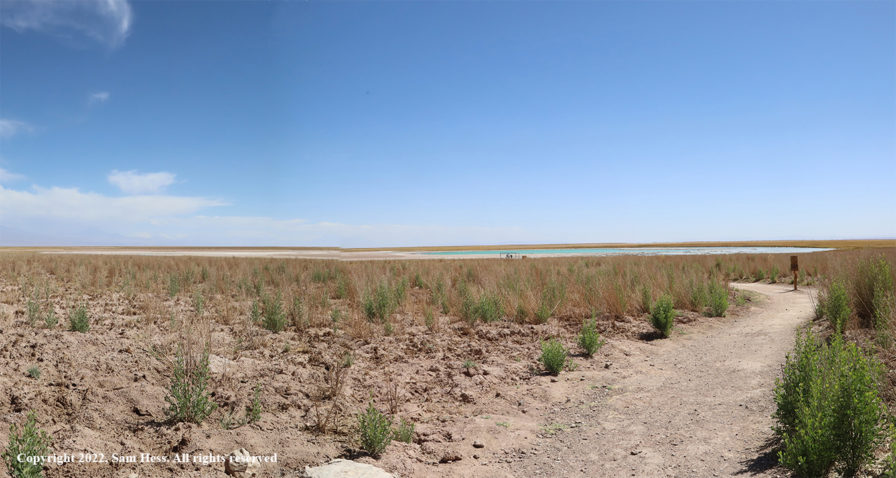
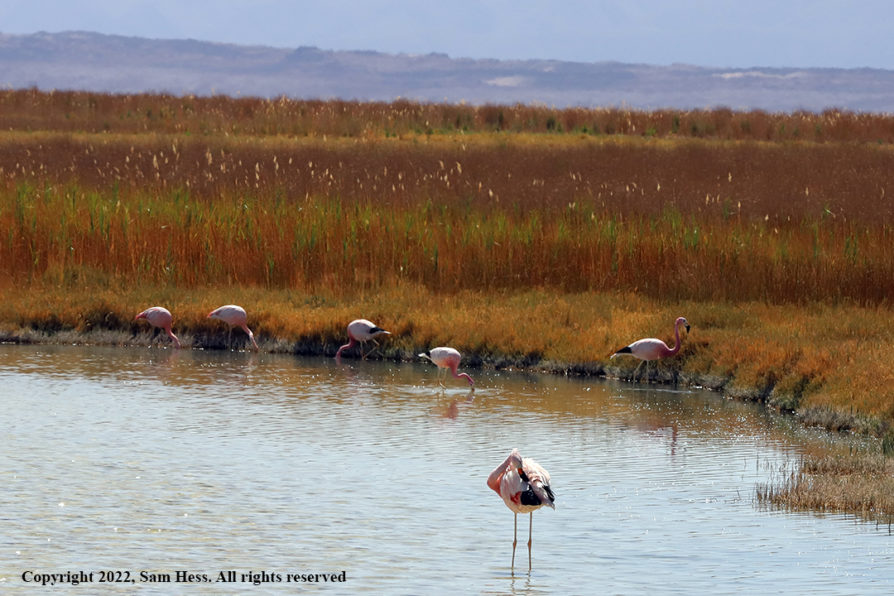
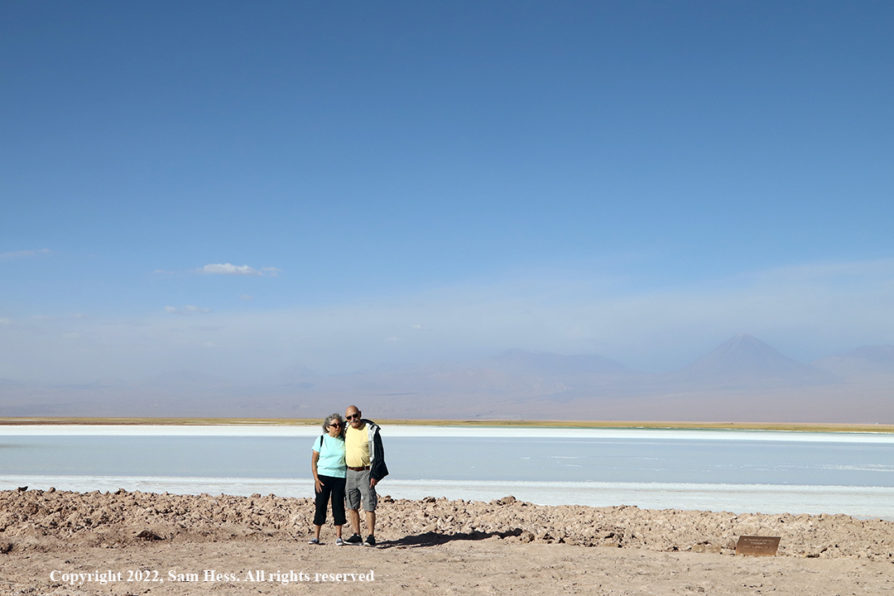
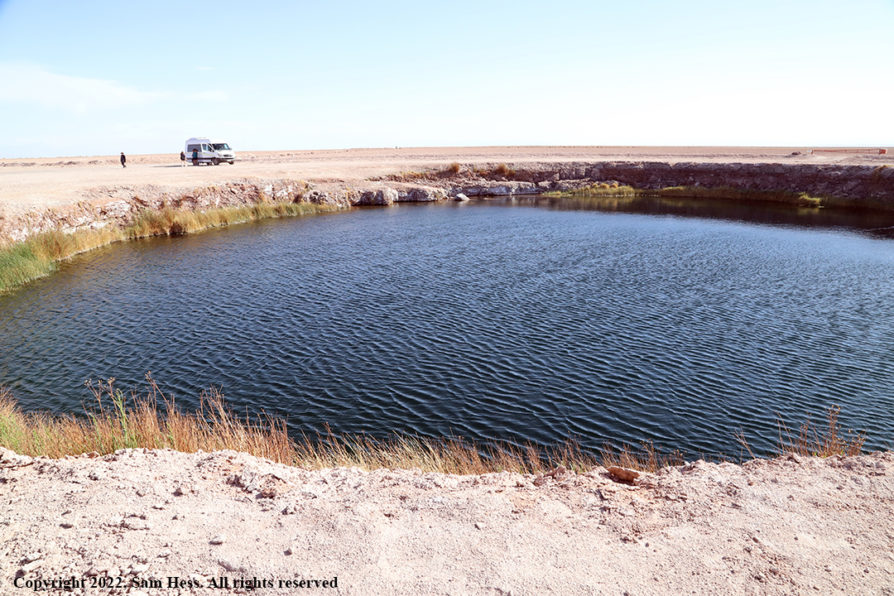
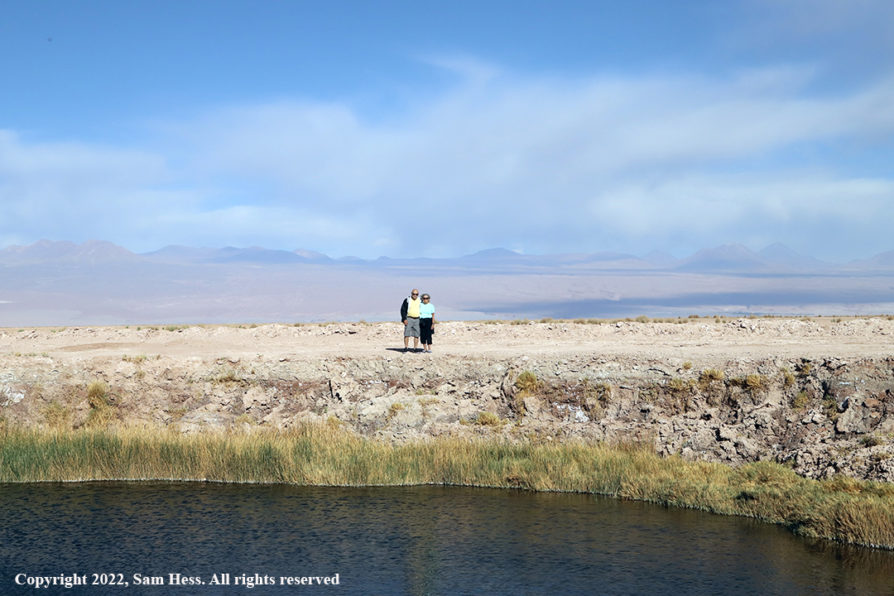
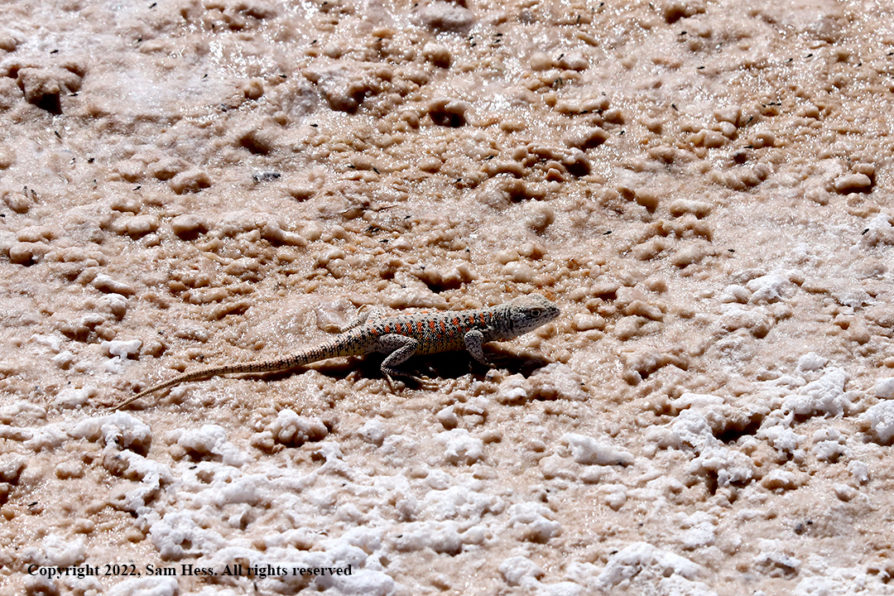
(It posed for this shot)
December 4, 2022-Toconao, Salt Flats and Chaxa Lagoon
A full day on the road (mostly unpaved). We were advised to wear layers because our trip will take to elevations in excess of 14,000 feet.
Our first stop was the oasis village of Toconao. The site of the village has been occupied for about 12,000 years. Since it was Sunday, the village was quiet, and we only saw a few people on the streets. The main attraction for us was the San Lucas Church (which was locked?) and its Bell tower, which dates back to 1744. The church itself was rebuilt in the late 1800s. The village is known for its woolen handicrafts… I guess they don’t work on Sunday.
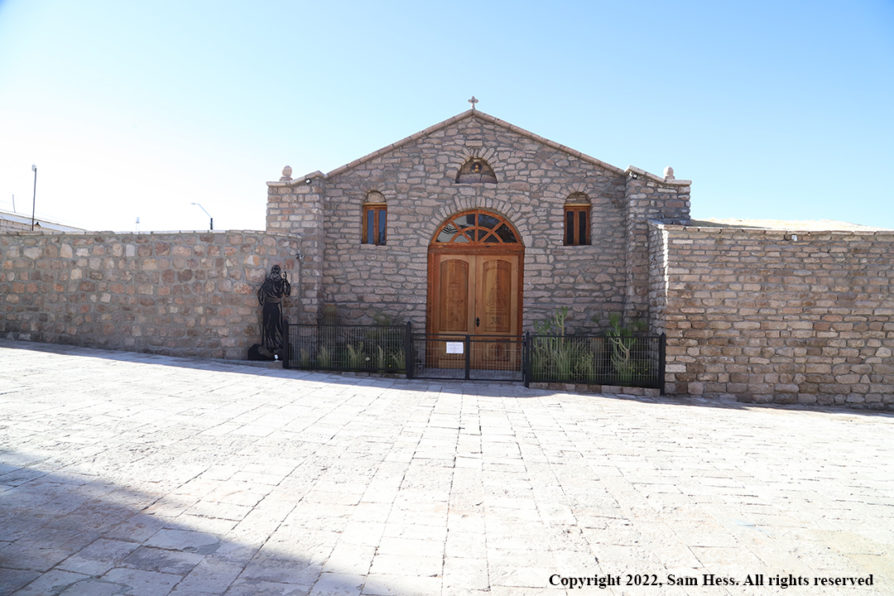
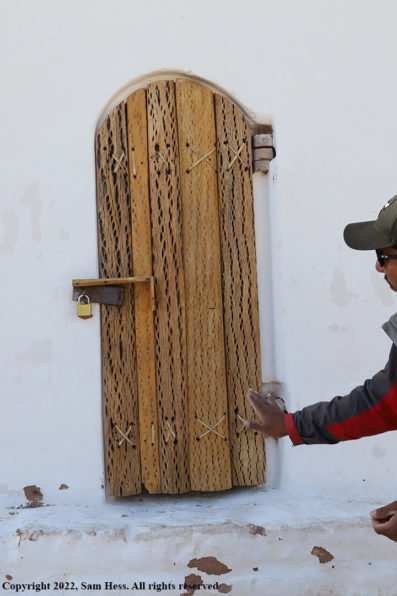
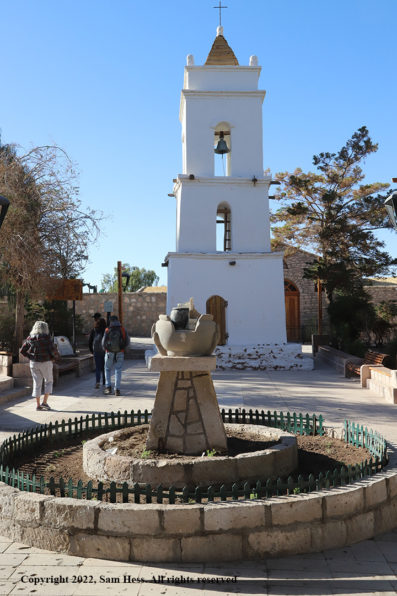
The four-foot-high Bell tower door is made from a local cactus that has a solid core. The only people to enter the tower are the nuns who serve the church.
Our next stop was the Salar de Atacama, the largest salt pan in Chile and the third largest in the world. Within the salt pan is Laguna Chaxa which is divided into several bodies of water and is home the three species of flamingos native to the Altiplano. We also traveled to see Laguna Miscanti and Laguna Miñiques located at 14,700 feet. There was a walking trail around the lagoons, but we only walked on a small section of the trails. It was here that we saw our first Vicuñas, one of the three camelid species native to this area. Vicuñas are wild animals while the Llamas and Alpacas are domesticated.
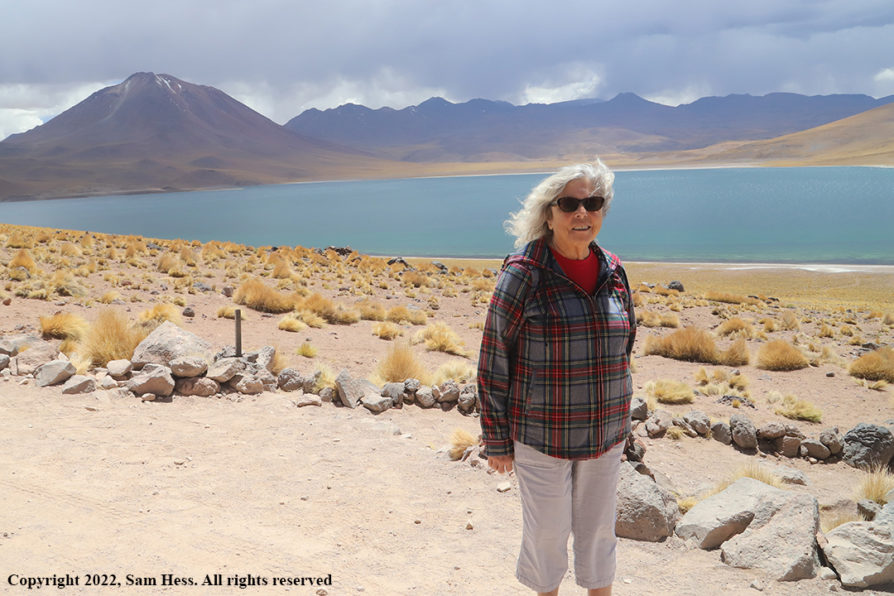
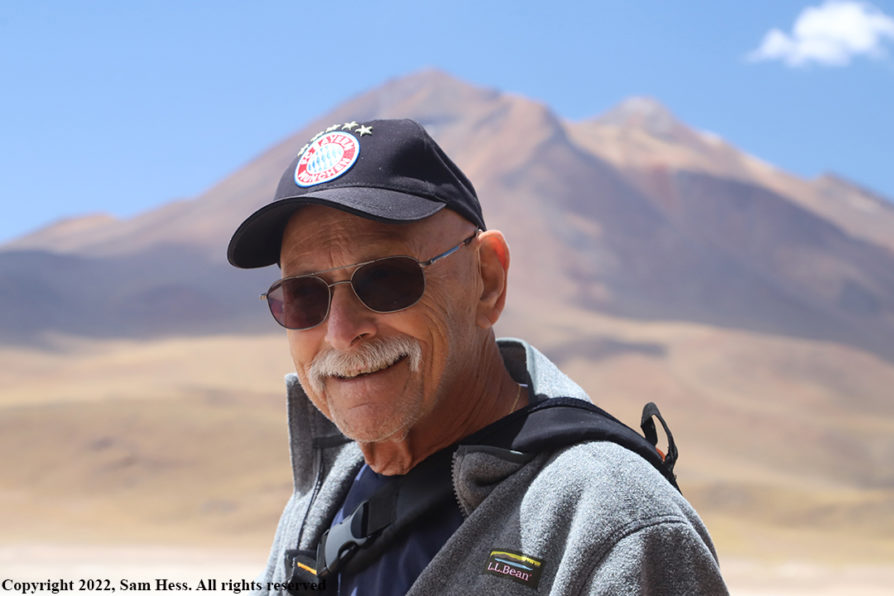
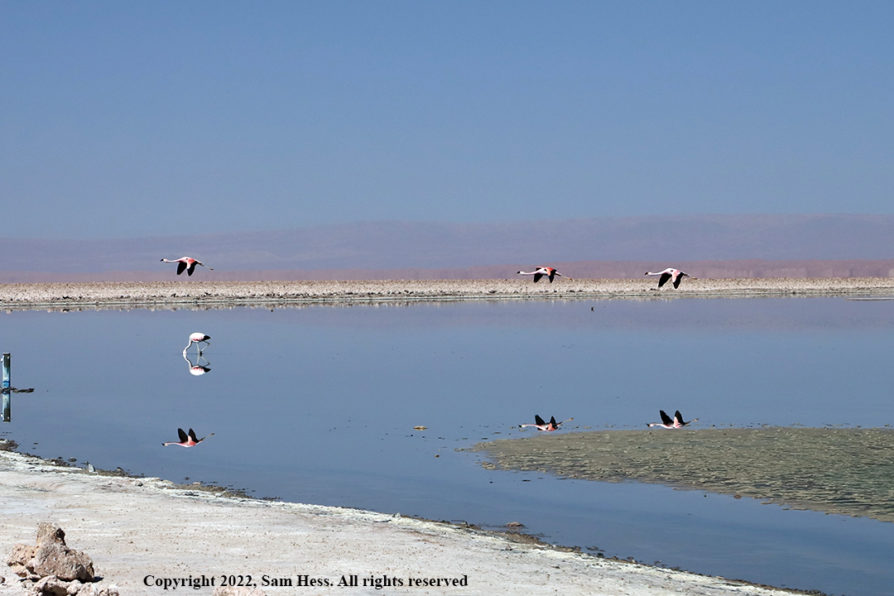
(Note mirror image)
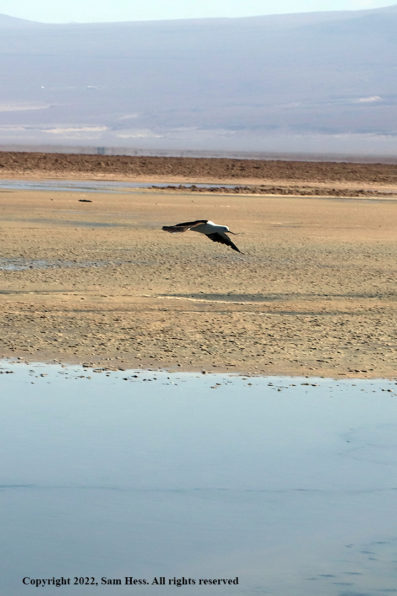
On our way back to San Pedro, we drove through Toconao. This time there were plenty of people on the streets. A soccer game had just finished and it seemed as though all of them were in or on the way to the local restaurants. Our guide had planned to have lunch in one of the restaurants, but it was full. We wound up having a late lunch in San Pedro.
This was a long day and tomorrow we the pick up was scheduled between 4:30 and 5:00 am. We decided to skip dinner and sleep.
December 5, 2022 – El Tatio Geyser Field
A pre-dawn pick up at the hotel for the hour and a half trip to the El Tatio Geyser Field. We were told that the best time to visit El Tatio was at sunrise because of the light shining through the steam presents the best view. Unfortunately, we were late in arriving and didn’t get any of pictures of that view.
The Geyser Field is located at an elevation of 14,000 feet. We were told to wear several layers when we going to this elevation… we were wearing three layers. It was quite cold and windy and I wished that I had taken a heavier mid-layer. The weather and the elevation combination took its toll on Susie and she went to the relative warmth of the tour van. I have to admit that I was tempted to join Susie.
When I think of geysers, the picture Old Faithful comes to mind. The geysers in El Tatio stay rise to about 30 inches. Old Faithful erupts to an average height of about 140 feet. Our guide stated that the atmospheric conditions can depress these geysers to even lower heights. The heat that powers the geysers and fumaroles comes from the magma pool below the surrounding volcanos.
The guide talked about the controversy surrounding the tapping into the area surrounding El Tatio and other geysers for geothermal energy uses. She was a strong opponent of this use, suggesting that it would have a detrimental effect on the geysers. Geothermal energy proponents discount this impact. In our travels in the Atacama Desert, we saw a number of geothermal energy plants.
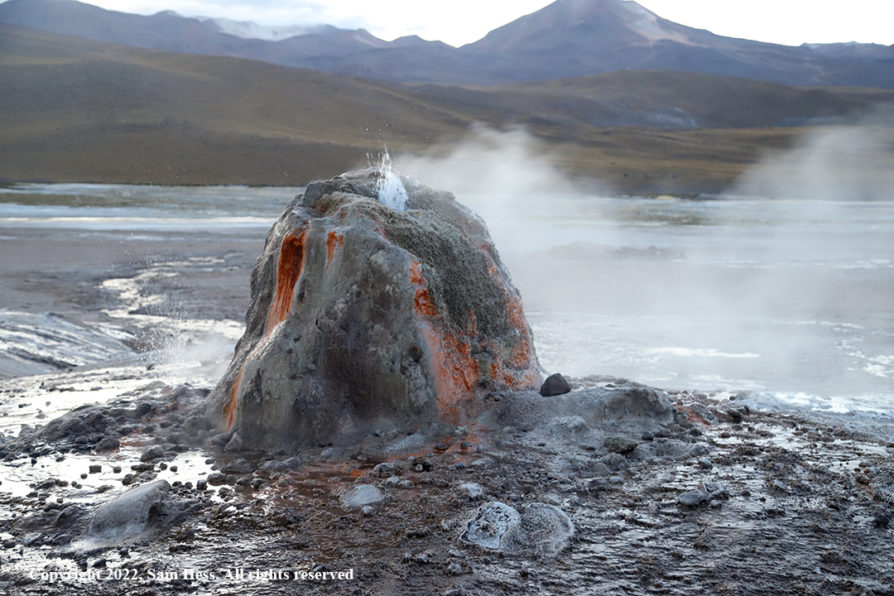
Colors are from minerals and bacteria.
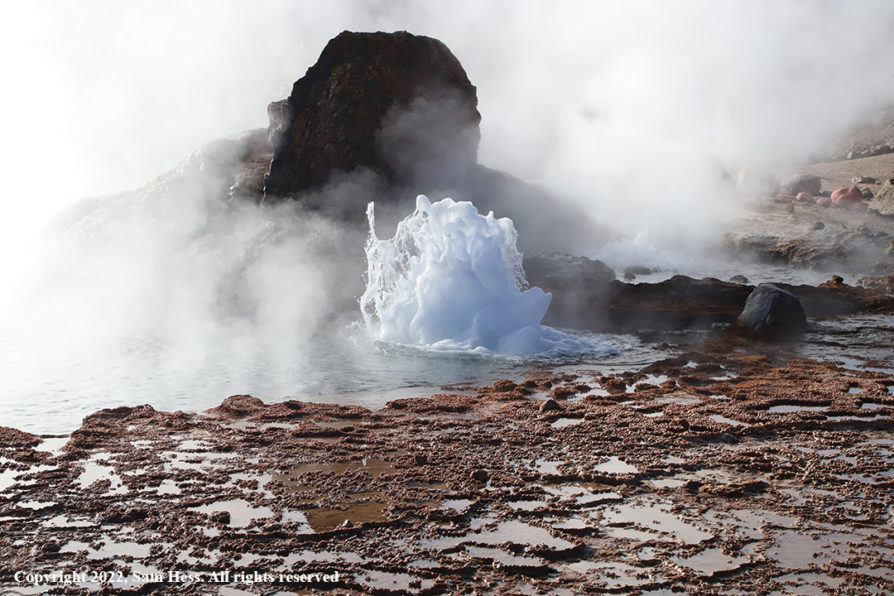
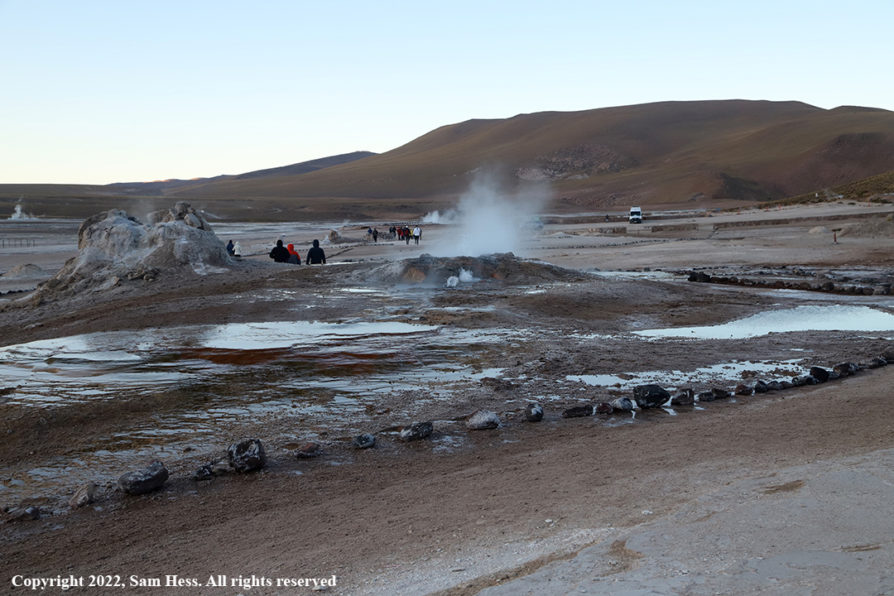
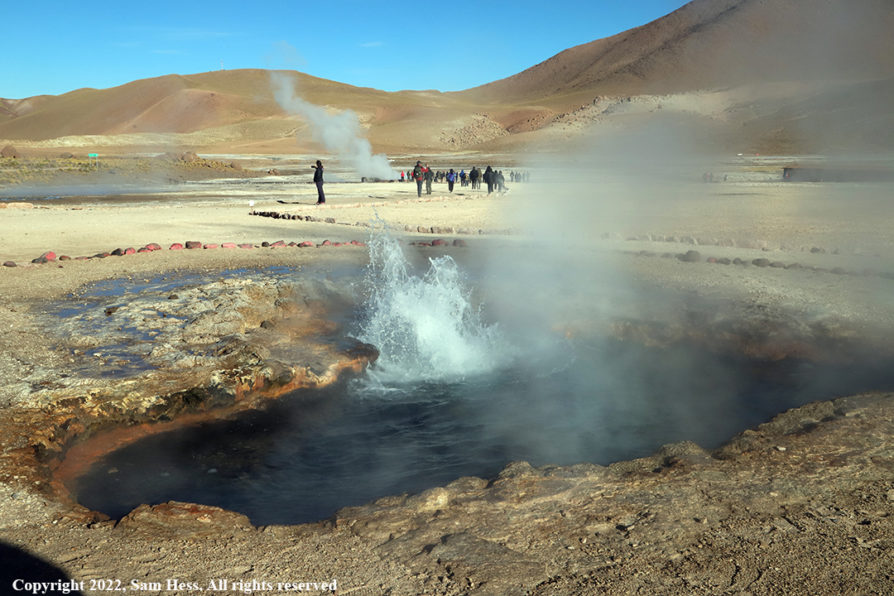
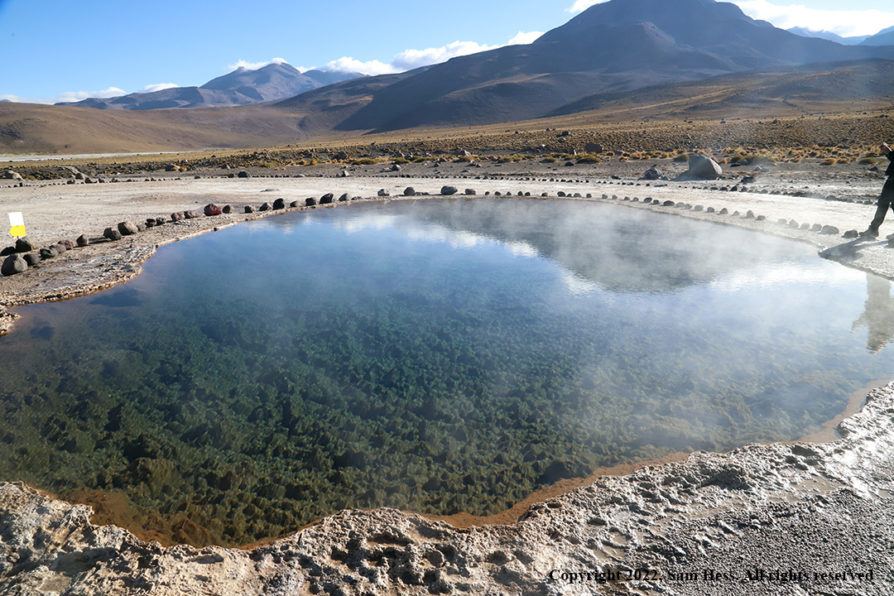
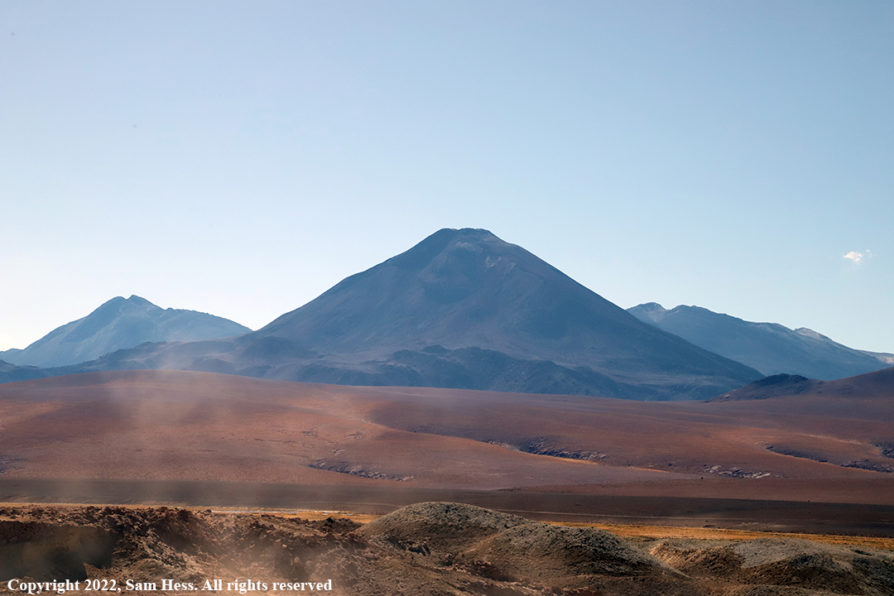
Cerro El Volcan (18,240 feet) in background
On the way back to San Pedro we stopped at a couple of lagoons to view several bird species. The most plentiful were the flamingoes. The lagoons also had vicuña grazing around the shore.
The tour advertised that breakfast was included. It turned out to be a brunch. We stopped at the ruins of a sulfur mine whose floor provided a level place for the driver to cook scrambled eggs. The table had plates full of rolls, avocado, and various meats and cheeses. The walls of the ruins served as shelter from the strong winds. We returned to our hotel around 11:30 am.
Bolivia
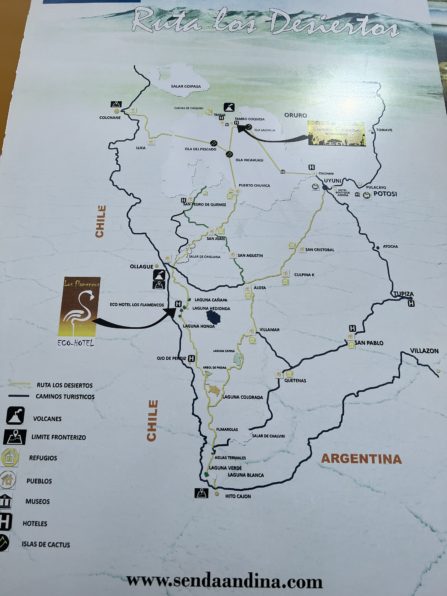
(photographed by Susie off the hood of our tour vehicle)
Most of the trip involved the unpaved “roads” (yellow lines)
December 6, 2022 – Bolivia Day 1
The trip to Bolivia is scheduled for three days and two nights. As you can see from the map above, most of the trip is on desert tracks.
A local driver picked us up for the hour-long drive on a paved highway to the Hito Cajon border crossing between Chile and Bolivia (elevation 14,698ft). We had to go through the Chilean immigration post to exit Chile located in a modern structure that we drove into for processing about a mile from the border. After clearing Chilean Immigration our driver proceeded to actual border where he turned us over to the Bolivian guide and her driver. The Bolivian border post is a small building. There were some issues with Bolivian Immigration that were resolved by our guide.
After leaving the border we traveled on dirt roads and desert tracks. Our first two stops were Laguna Blanca (White Lake) and Laguna Verde (Green Lake).
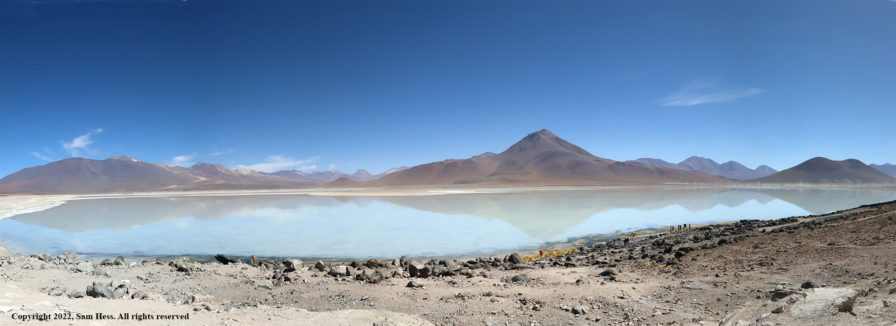
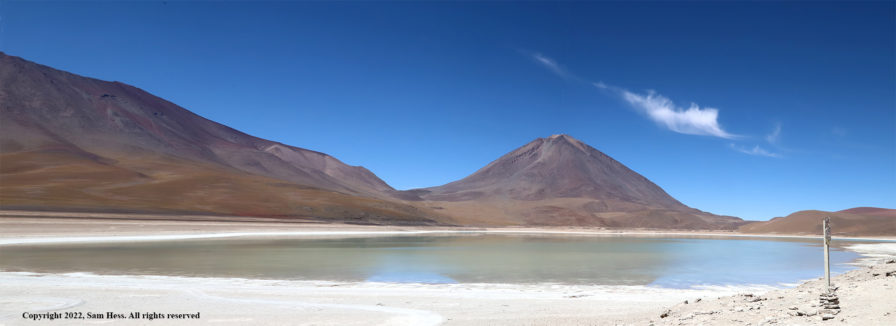
We continued our travels via desert tracks. There were a few more salars on our route. One of the spots we visited was Arbol de Piedra, a formation created by desert winds and airborne sand. There were other similar examples of the work of the combination of wind and sand erosion.
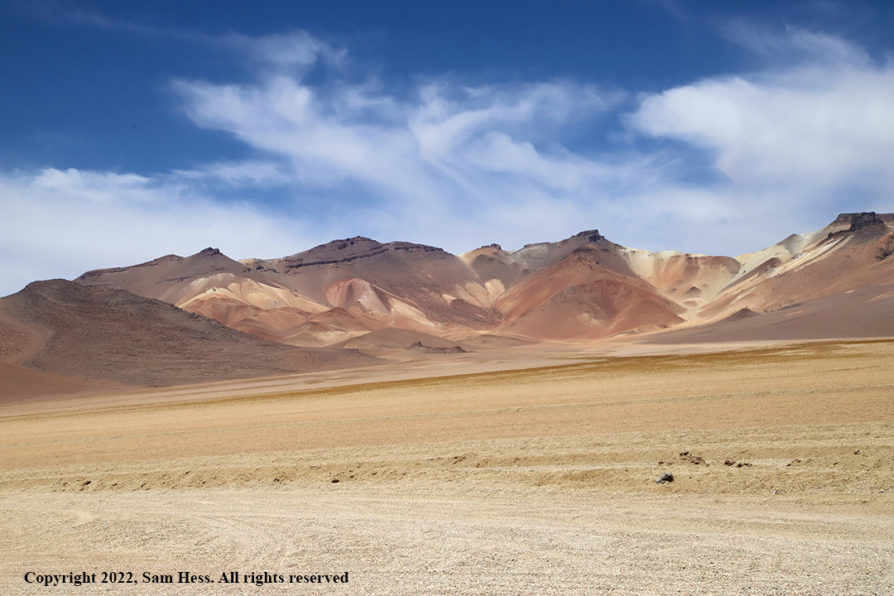
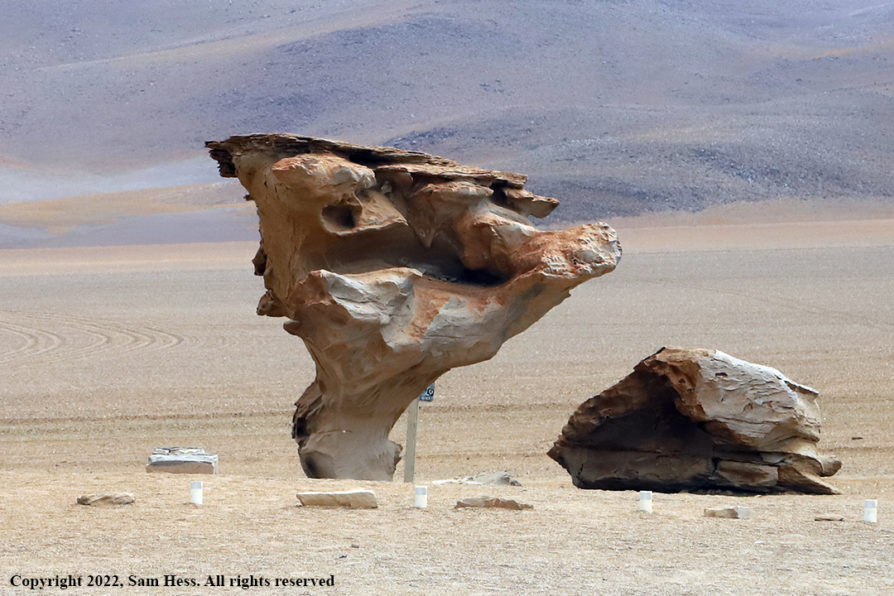
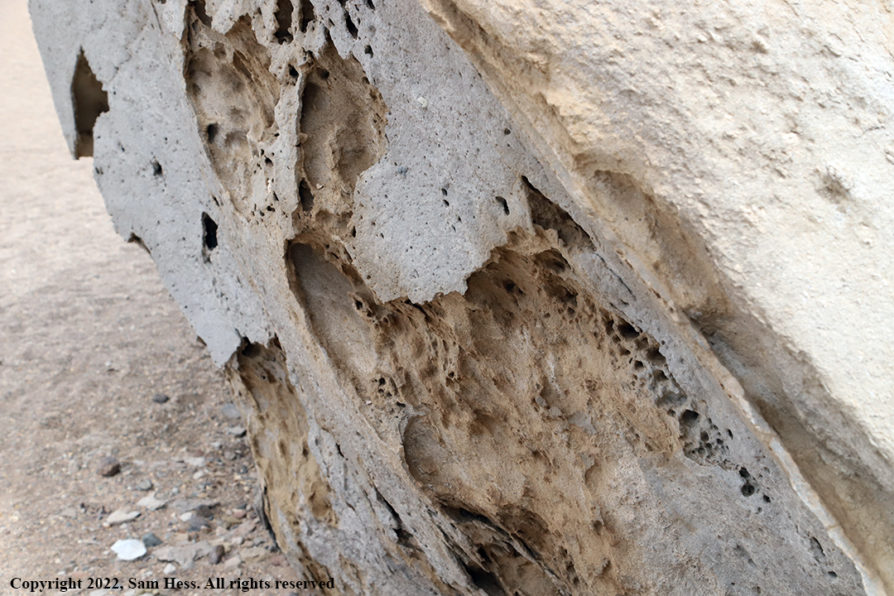
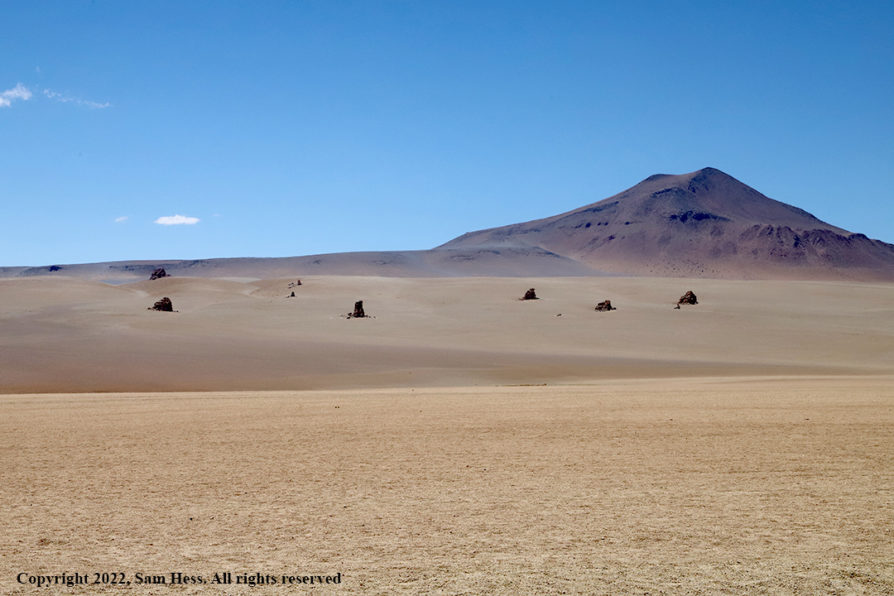
One of the few mammals we saw among the rocks in the desert was the Viscacha, a rodent that looks like a cross between a rabbit and a squirrel. The one pictured below seemed not to be to concerned with our presence. I got quite close to it get the picture below.
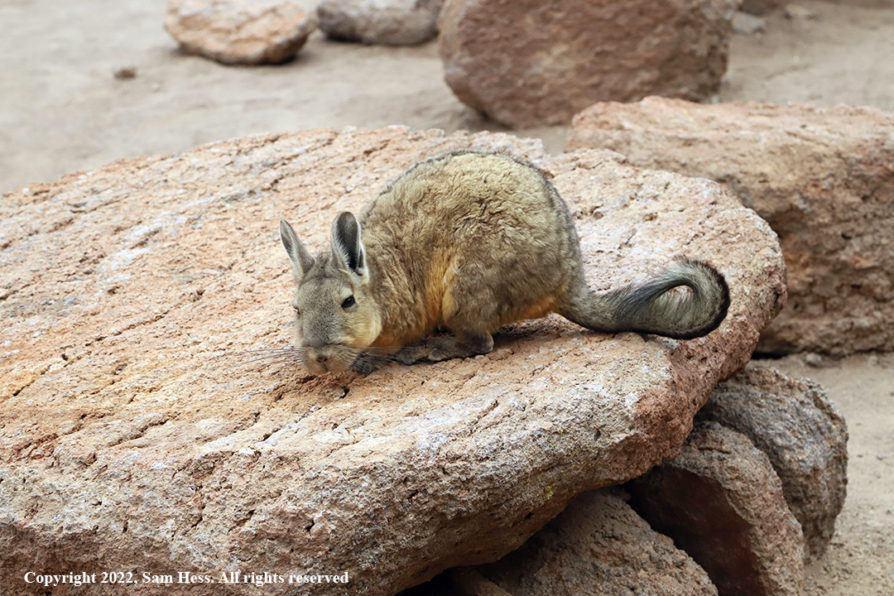
Our final destination for the day was the Los Flamenecos Eco Hotel, located on the shore of the Laguna Hedionda. The hotel is remote and only powered by solar panels. Apparently the capacity is limited as power was only available from 6 to 10pm. There is no heat at night or hot water for the morning shower.
The saline lake had a large population of flamingos that I was going to photograph after we settled into our room. Our window overlooked the lake and unfortunately, that was the only view I was going to get. It started pouring soon after we got into the room and didn’t stop until the overnight hours. It was the rainy season, but the heavy rains usually come later in the season. I tried to get pictures prior to breakfast but couldn’t get out as the main entrance seemed to be locked. On the plus side, dinner and breakfast were very good.
December 7, 2022 – Day 2
Today we are going to traverse the Uyuni Salt Pan, the largest salt pan on earth. We woke up this morning to discover that our heavy overnight rain dropped a cover of snow on the mountains.
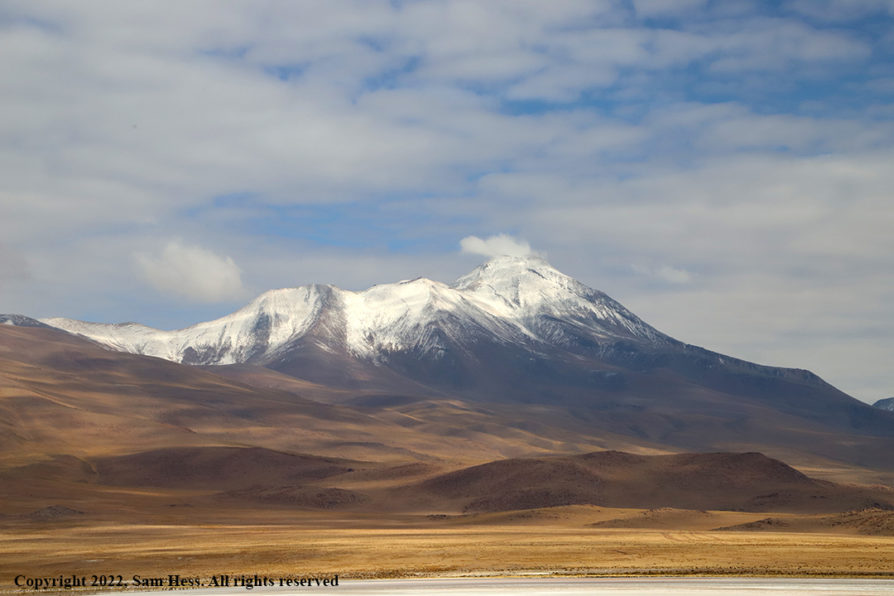
We had a bit of a drive to get to the Uyuni Salt Pan from our overnight stop. The route we took over the desert held some spectacular views.
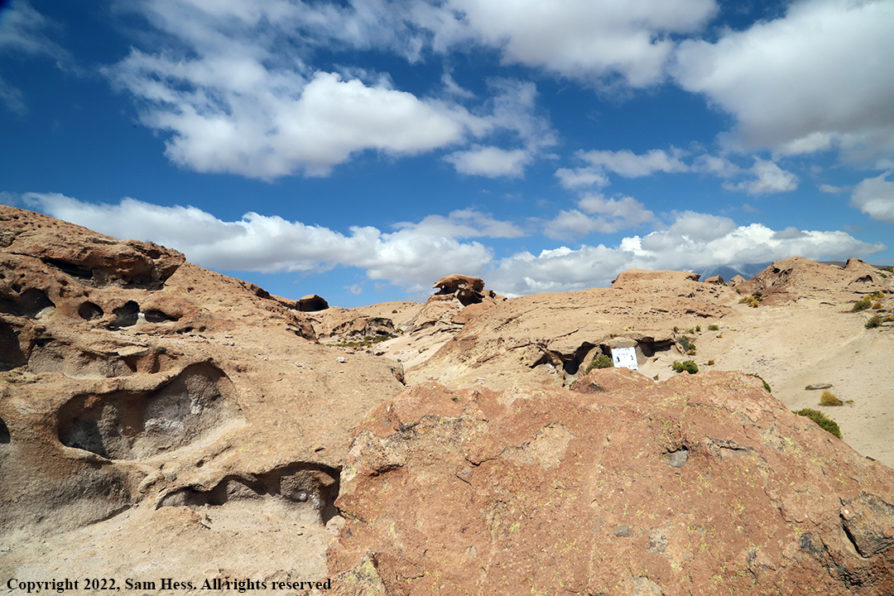
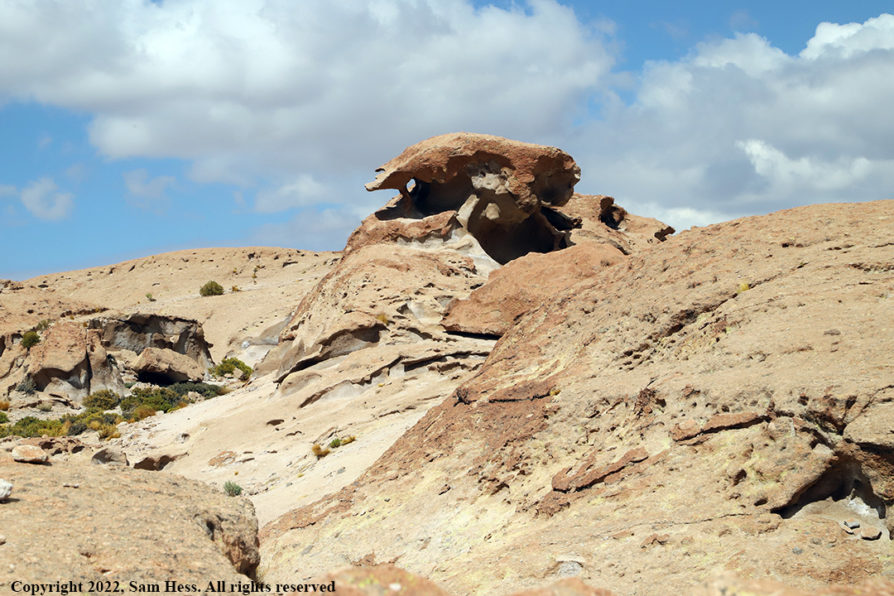
We drove through several communities this morning. Enroute we could see fields planted with Quinoa. The fields have been recently planted and only tiny green leaves are showing. They will eventually reach 3 to 7 feet high.
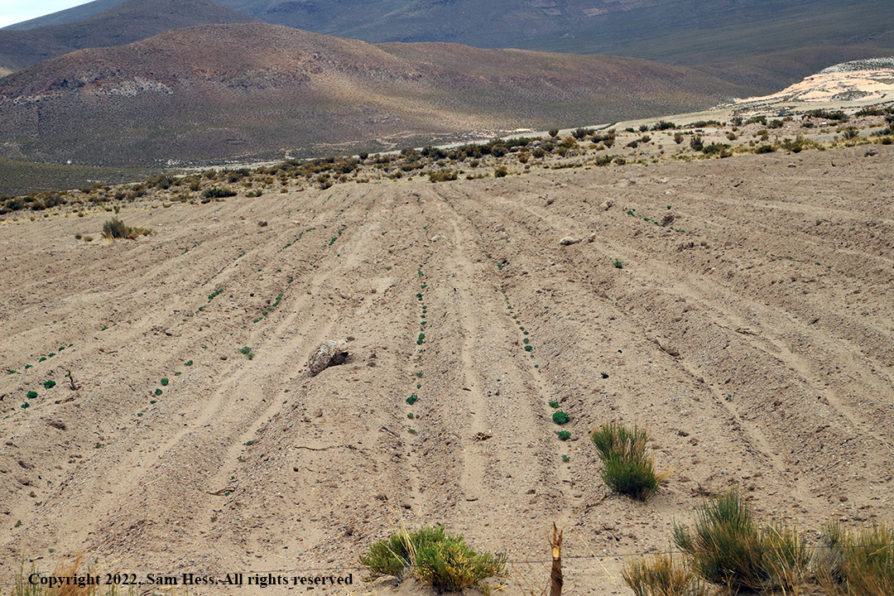
After some travel we reached the salt pan. Once on the salt pan there are no tracks. How the driver and guide navigated to get to specific destination is amazing to me. When you get further on the pan all you can see is nothing but white salt and mountains (some of which are mirages floating in the air).
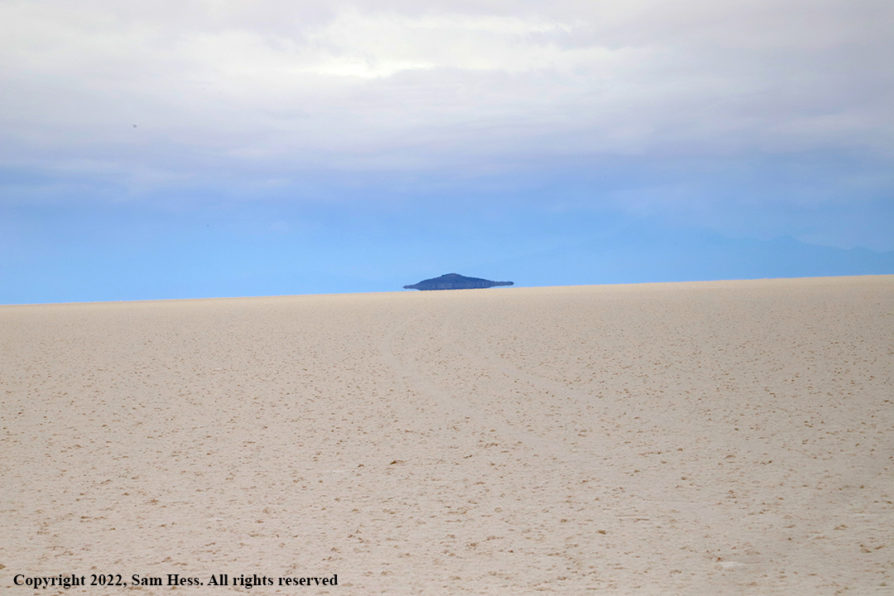
We stopped for lunch on the salt pan. As in the previous day, it was a white tablecloth banquet. Our guide, Aida, who is part Quecuha, entertained us with a traditional dance.
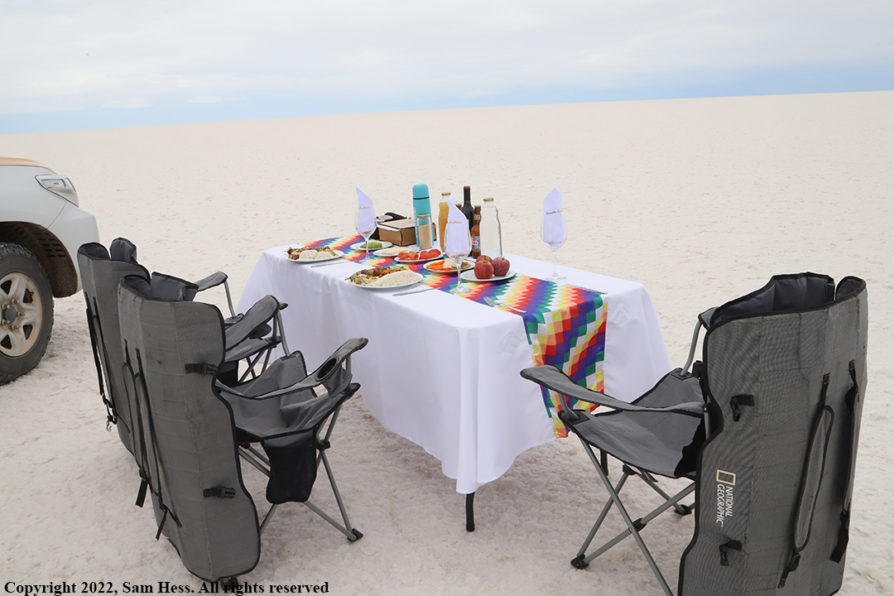
Note the horizon shows nothing but salt… no land features.
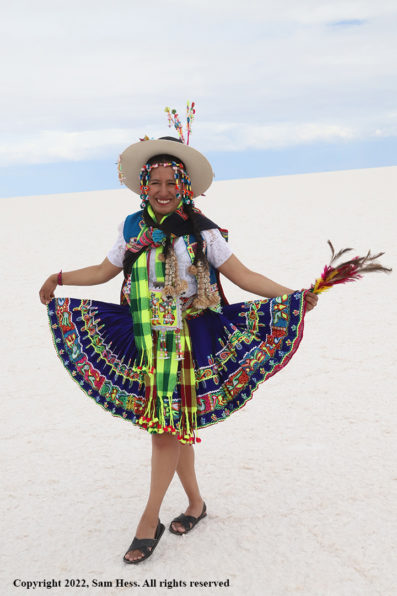
There are several islands on the flat and we stopped at Incahuasi Island. The Island is the top of a volcano that existed millions of years ago below an inland sea. Coral fossils are readily found on the island. It is also covered by large cacti that we also noticed in the Atacama Desert.
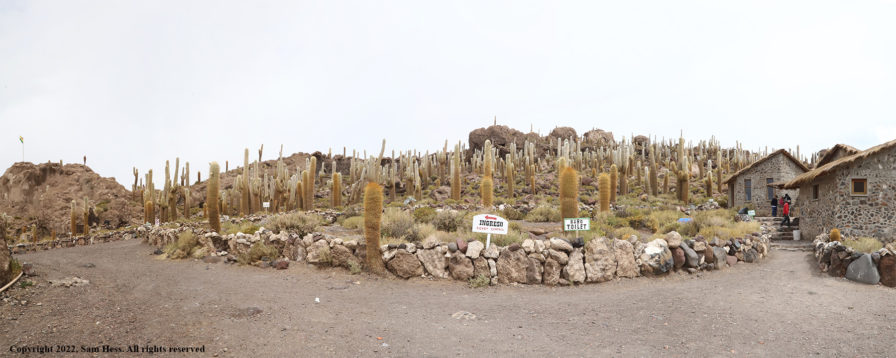
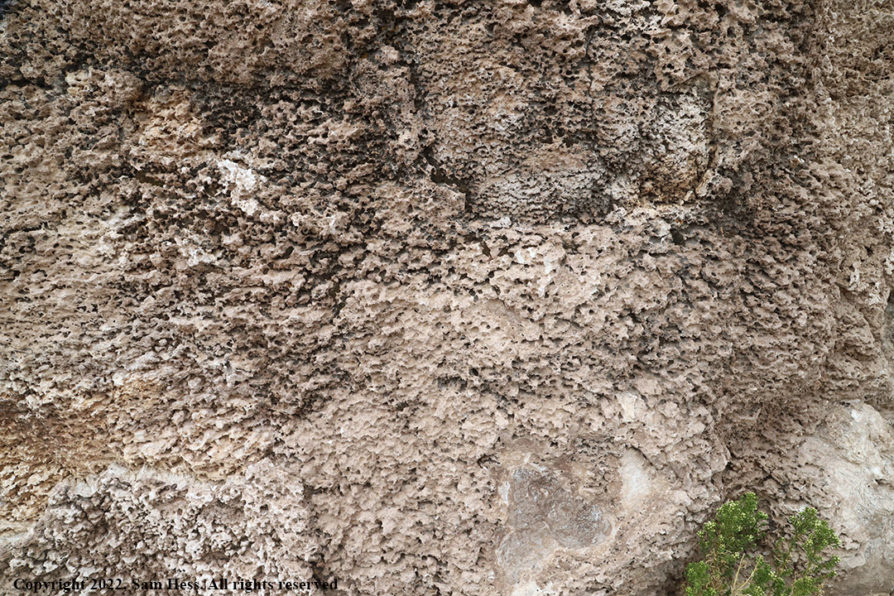
Our final stop for the day is the Hotel Tambo Coquesa Lodge. The property contains a main lodge and some cabins. Our cabins is made out of blocks of salt. The exterior is covered on stucco to waterproof the salt walls. Even some of the furniture is made out of the same salt blocks. The plan for the evening was to watch the sunset out on the salt pan with Champaigne and snacks. As in the previous evening, it started to rain lightly. The clouds hid the sunset, but we had our drinks on the salt anyway.
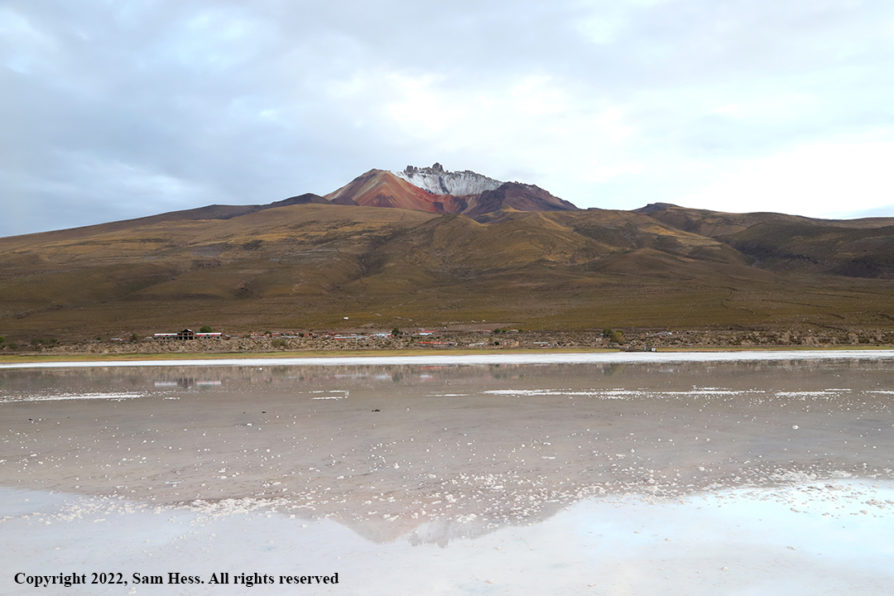
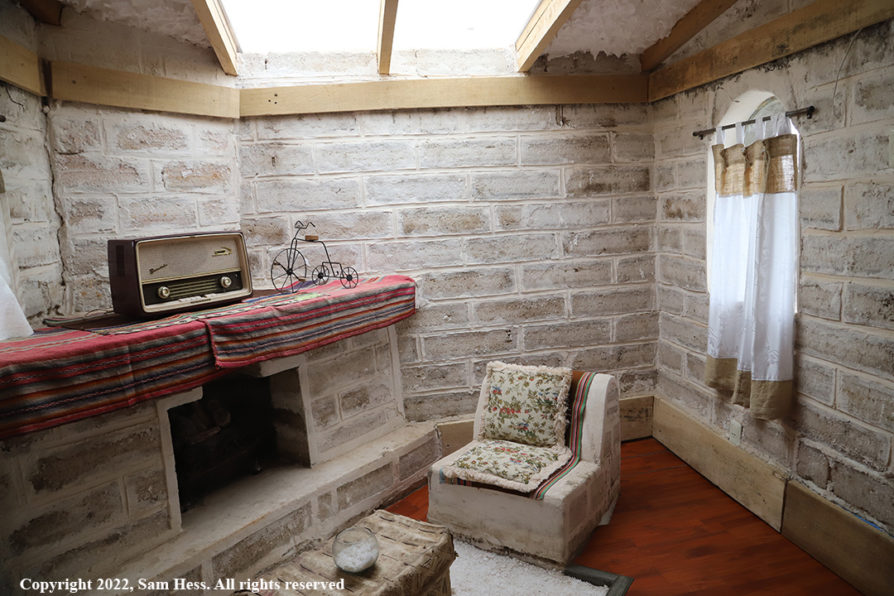
December 8, 2022 – Back to San Pedro de Atacama
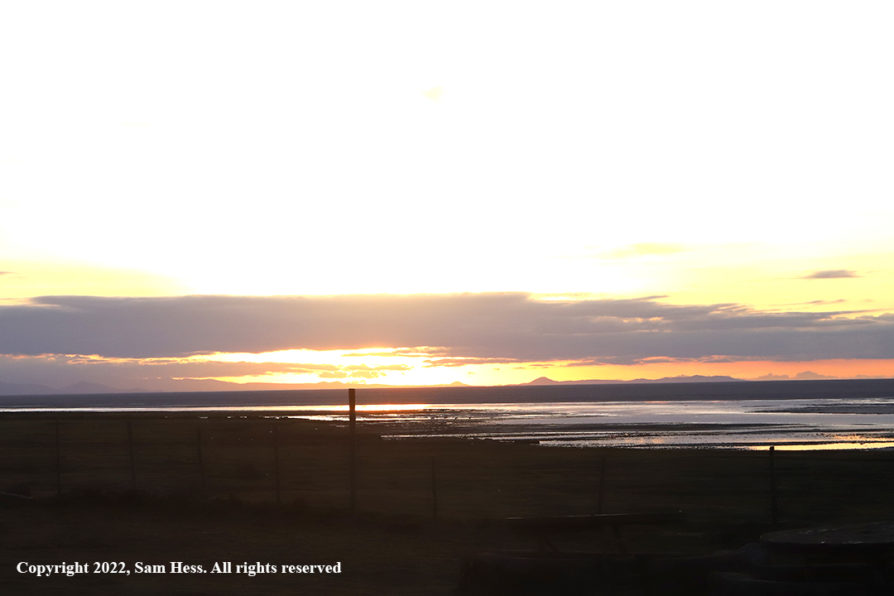
After breakfast we started our return to Chile. After roughly three hours of driving on the salt pan, we reached the city of Uyuni. We had snacks while our driver fueled up the car for the driver Hito Cajon border crossing.
On our way we passed a number of salt harvesting and processing locations on the pan. After leaving the Uyuni Salt flat we stopped in the silver mining town of San Cristobal. A mining company wanted to build an open pit mine but the town occupied the site. The company offered jobs to any person in the town, built new homes and relocated the church.
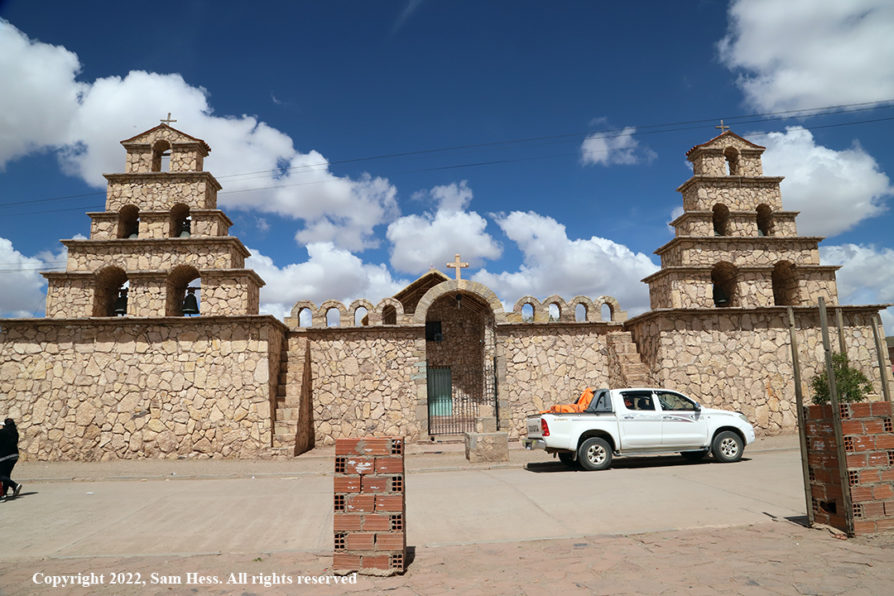
We stopped for lunch at a hostel and watched Llamas and Alpacas grazing below. Alpacas are distinguished from Llamas by their smaller size and facial hair.
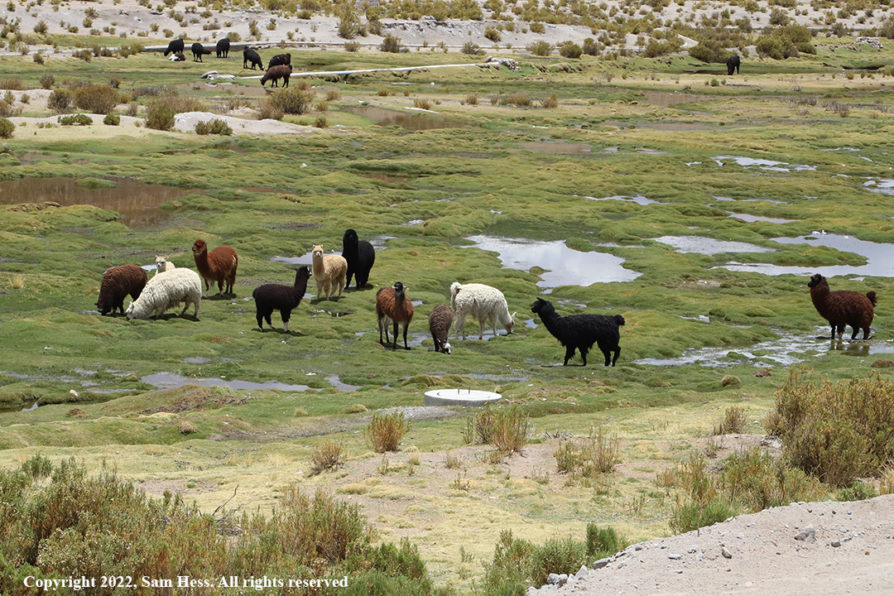
On the way to the border crossing, we crossed a pass above 15,000 feet. The remnants of the snow were all around us.
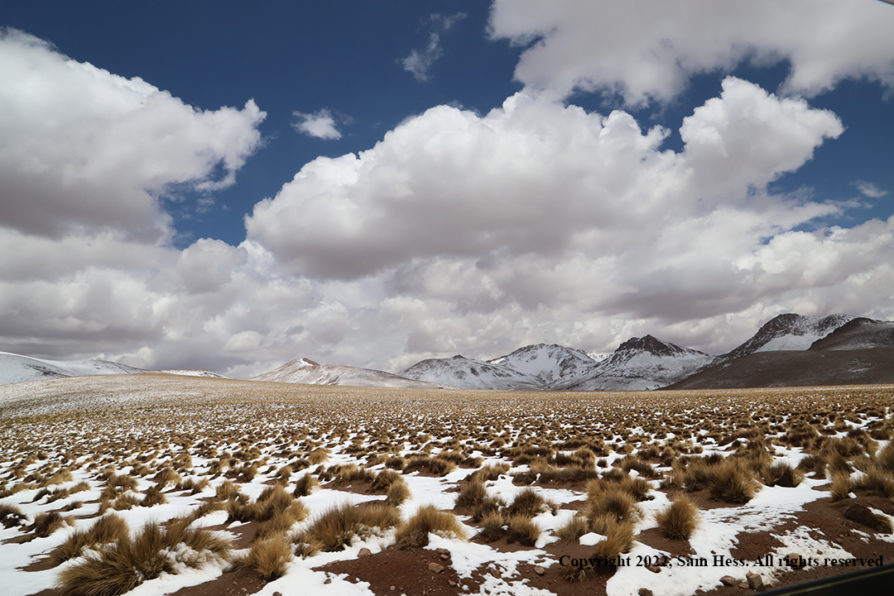
The crossing from Bolivia to Chile was uneventful. We transferred from our Bolivian guide and driver to a Chilean driver who took us back to our hotel in San Pedro.
December 9, 2022 – San Pedro de Atacama – Valle de Luna
This morning we began at a normal hour. We checked out of the hotel and were met by our guide for a tour of the Valle de Luna (Moon Valley). The valley gets its name because some of its terrain resembles the craters of the moon. The valley terrain was, and continues to be, shaped by the wind.
Our guide was a very knowledgeable and interesting person. He guides only periodically and lucky for us this was one those days. It was a pleasure to spend half a day with him.
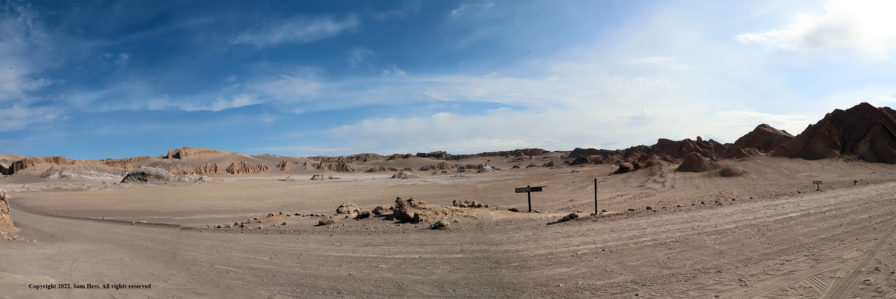
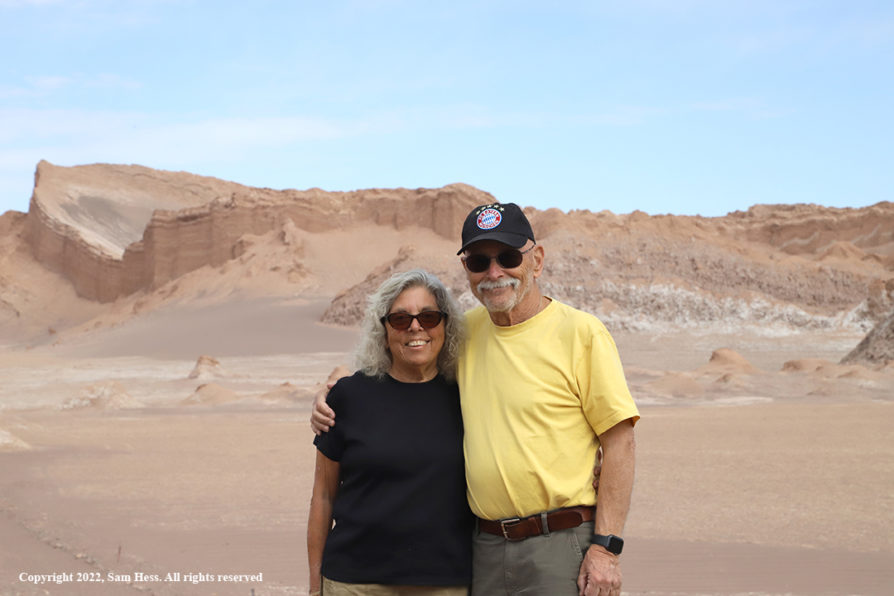
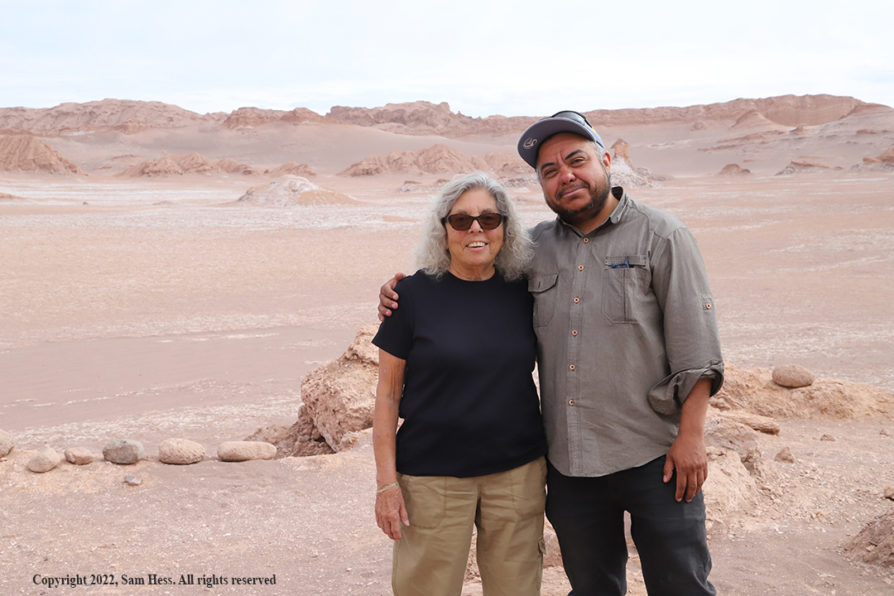
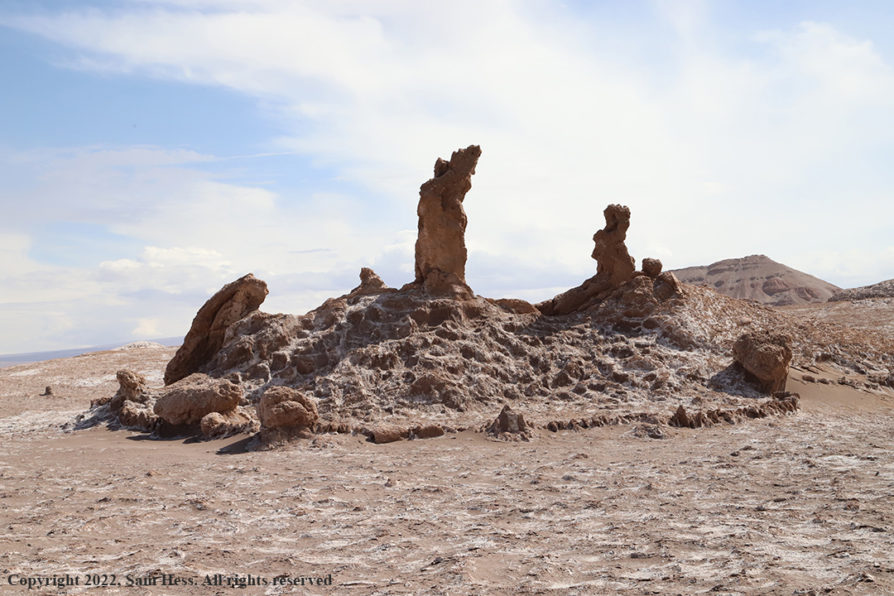
The wind keeps shaping this formation until it completely disappears.
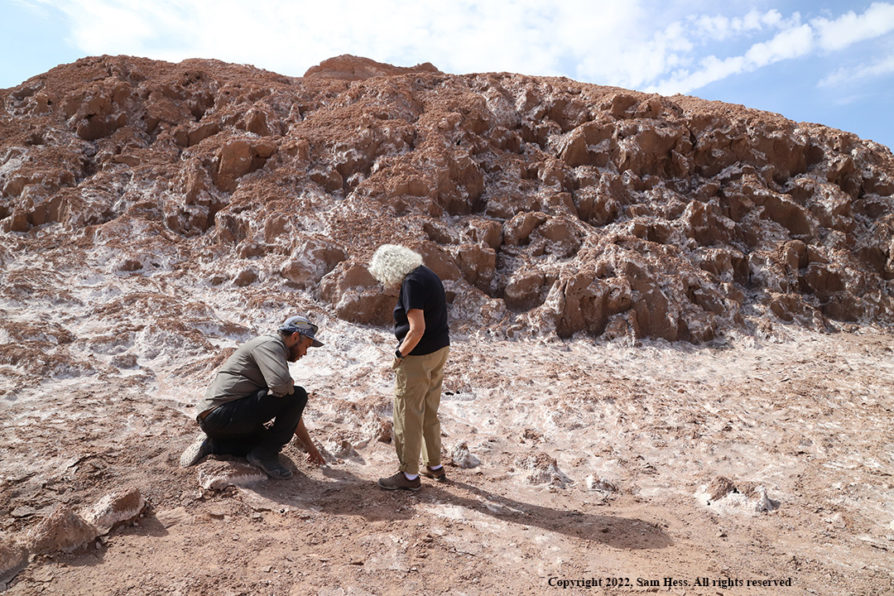
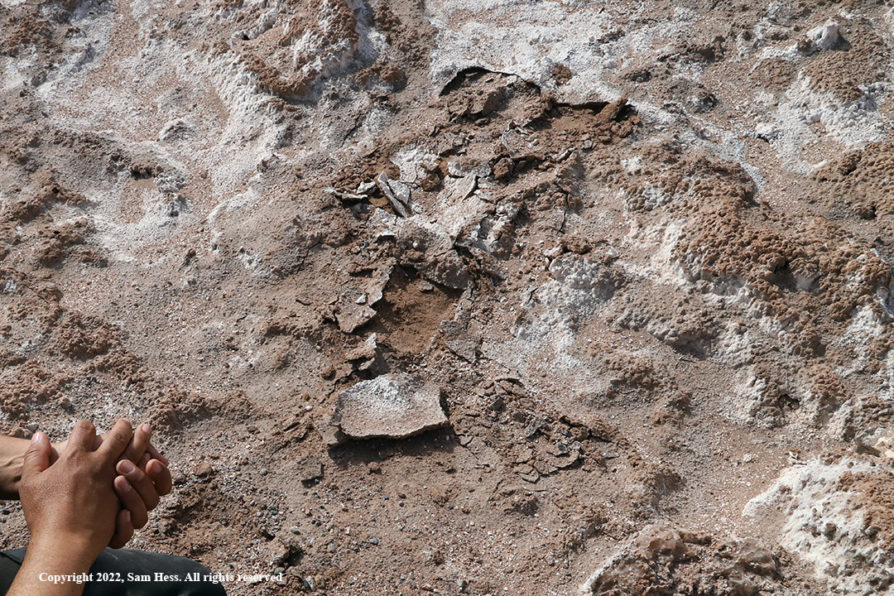
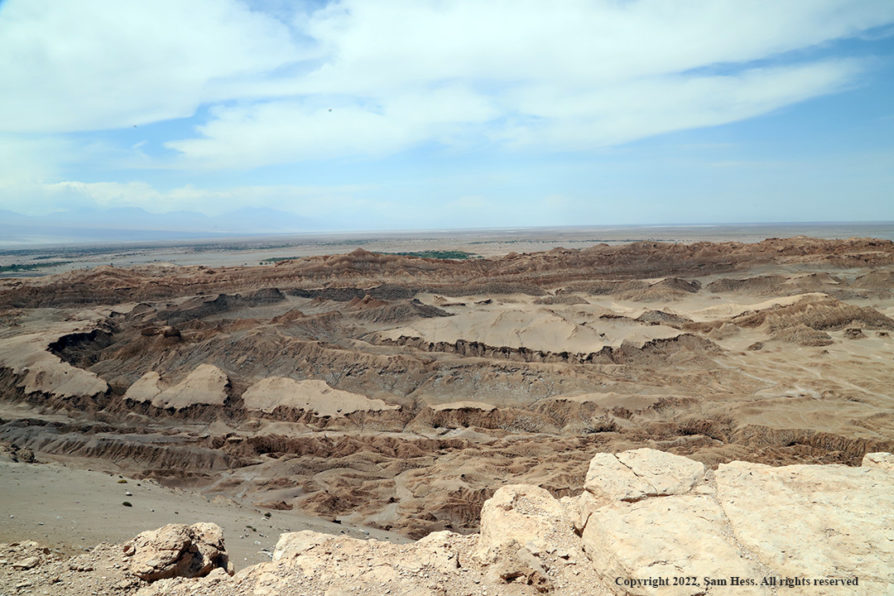
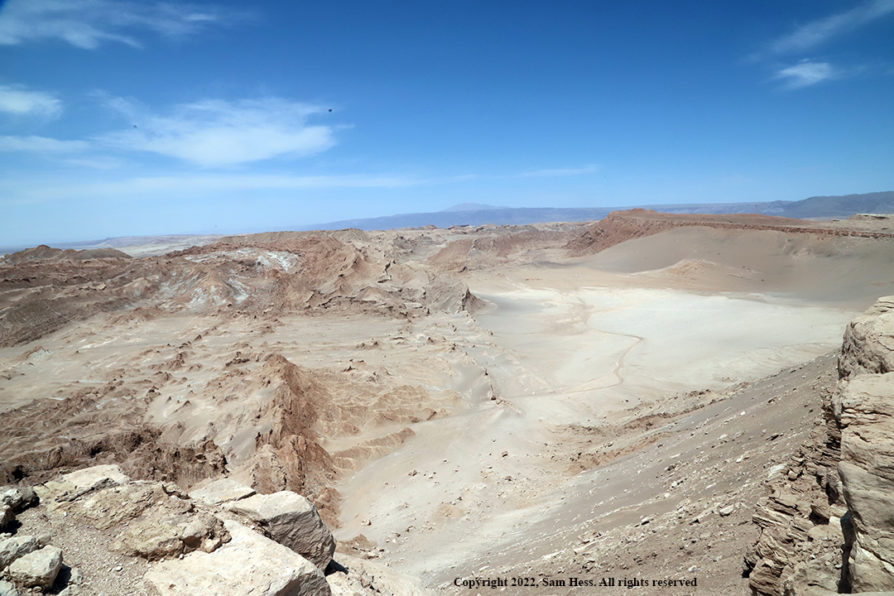
Our journey to the Atacama Desert and Bolivia is now over. Our guide was also our driver to Calama airport for the trip back to Santiago. Susie and our guide exchanged contact information. When we got off the plane in Miami on December 10th, Susie received a text advising us that the Lascar Volcano erupted ten hours after we left the Valle de Luna. The eruption had a plume that rose 3.1 miles high and spread volcanic ash all over the area we had just left.
And now on to our next adventure, a Caribbean cruise with our New York (some now living in Florida) traveling friends.